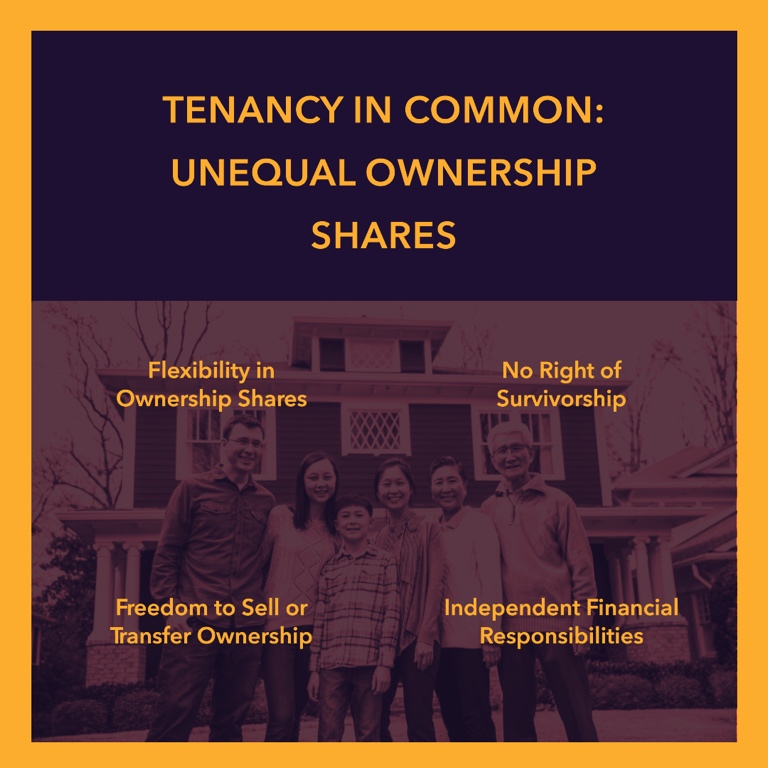If you’re struggling to get your first foot on the property ladder, you may want to consider buying a house with your parents.
In this guide, we’ll cover everything you need to know, including:
- Key aspects to consider
- Ownership structures
- Real life scenarios
- Pros and cons of joint ownership
- And much more
Read on to learn how buying a house with your parents can help you get started on your property journey.
Table of Contents
Buying a home with your parents: key aspects to consider
Teaming up with parents to buy a home can provide several advantages if you’re looking to enter the property market sooner. Here are some key aspects to consider when buying a home jointly with your parents:
You'll Get a Leg-up on the Property Ladder
One of the primary benefits of buying a home jointly with parents is the ability to overcome the financial barriers that often hinder first home buyers.
By pooling resources, you can much more easily save up for a deposit, making it easier to secure a home loan and enter the property market.
This can significantly speed up the homeownership journey and allows you to build equity and wealth at an earlier stage of your life than would otherwise be possible.

How will your structure the ownership?
When buying a home jointly with parents, it’s essential to carefully consider the ownership structure that best suits your situation.
The two common ownership structures are joint tenancy and tenancy in common. Each has its own implications and considerations:
Joint Tenancy: In joint tenancy, all parties involved have equal ownership shares in the property. If one owner passes away, their share automatically transfers to the surviving owner(s). This structure ensures seamless transfer of ownership and avoids potential conflicts or disputes. Joint tenancy is often preferred when parents intend to transfer their share of the property to their children in the future.
Tenancy in Common: Tenancy in common allows for unequal ownership shares. Each party can own a specific percentage of the property, which can be determined based on financial contributions or other arrangements. In the event of an owner’s passing, their share can be passed on to a beneficiary of their choosing. Tenancy in common provides more flexibility in terms of ownership distribution and can accommodate varying financial contributions or circumstances.
It’s crucial to consult with a legal professional to understand the legal and financial implications of each ownership structure and determine which option best aligns with your needs and preferences.
We’ll cover this point in more detail later on in this guide.

Who will be living in the house?
Another important aspect to consider when buying a home jointly with parents is who will be living in the house. This factor can influence the ownership structure and financial responsibilities. Here are some common scenarios to contemplate:
Living Separately: You may decide to live in the house while your parents live in their current property. In this case, you may agree to pay a fair market rent for your parents’ share of the property, or come to another agreement.
Shared Occupancy: If both you and your parents plan to live in the property, it’s essential to determine the proportional share of each party’s ownership and contribution to expenses, such as mortgage repayments, utilities, and maintenance costs.
Investment Property: If you’re intending to buy the property as an investment and rent it out, ownership shares and responsibilities should be allocated accordingly, considering factors like rental income distribution and management.
Considering the occupancy arrangements and discussing them openly with your parents can help establish clear expectations and avoid potential conflicts or misunderstandings in the future. It’s advisable to seek legal and financial advice to ensure all parties are protected and informed.

Case Study: Emma and her Parents' Home Purchase Journey
To illustrate the mechanics of buying a home with parents, let’s take a look at the case of Emma, a young Australian seeking to enter the property market. Emma’s parents generously offered to help her by co-purchasing a property together. Here’s how they navigated the process:
1. Exploring Ownership Structures
Emma and her parents discussed the different ownership structures available, weighing the pros and cons of joint tenancy and tenancy in common. They opted for joint tenancy to ensure a seamless transfer of ownership in the future.
2. Determining Ownership Shares:
They decided on an equal ownership split, with each party having a 50% share in the property. This arrangement ensured fairness and aligned with their financial contributions.
3. Defining Financial Responsibilities:
Emma and her parents outlined their financial responsibilities, including mortgage repayments, property maintenance costs, and utilities. They agreed to contribute proportionally to their ownership shares, sharing the financial obligations equitably.
4. Establishing Occupancy Arrangements:
Emma planned to live in the property, while her parents would reside elsewhere. They established a rental agreement where Emma paid her parents fair market rent for their share of the property.
By carefully considering the mechanics of buying a home with parents, Emma and her parents successfully navigated the process, ensuring clarity and mutual understanding throughout their homeownership journey.

Ownership structures for buying a house with your parents
To delve deeper into the mechanics of buying a house with your parents, it’s crucial to understand the different ownership structures available and their implications. Let’s explore joint tenancy and tenancy in common in more detail:
Joint Tenancy: Equal Ownership Shares
Joint tenancy involves equal ownership shares among all parties. Here are some key points to consider:
Seamless Transfer of Ownership: In joint tenancy, if one owner passes away, their share automatically transfers to the surviving owner(s) without the need for probate or additional legal processes. This feature ensures a smooth transfer of ownership and avoids potential conflicts.
Right of Survivorship: The right of survivorship is a critical aspect of joint tenancy. It means that if one owner passes away, their share is automatically divided equally among the surviving owner(s). This provision helps maintain the continuity of ownership and simplifies the distribution of assets.
Limited Control Over Disposal: In joint tenancy, each owner has the right to sell or dispose of their share of the property. However, they cannot sell or transfer their share without the consent of the other owner(s). This requirement protects the interests of all owners and ensures mutual agreement on any changes to the ownership structure.
Joint tenancy is often chosen when parents wish to transfer their share of the property to their children in the future or when equal ownership shares are desired.

Tenancy in Common: Unequal Ownership Shares
Tenancy in common allows for unequal ownership shares based on financial contributions or other arrangements. Here’s what you need to know about tenancy in common:
Flexibility in Ownership Shares: Unlike joint tenancy, tenancy in common permits different ownership percentages. Each party can own a specific share of the property, which can be proportional to their financial contributions or any other arrangement agreed upon.
No Right of Survivorship: In tenancy in common, there is no automatic transfer of ownership shares upon an owner’s passing. Instead, the owner can designate a beneficiary in their will or rely on the laws of intestacy to determine the distribution of their share.
Freedom to Sell or Transfer Ownership: Unlike joint tenancy, owners in a tenancy in common have the freedom to sell or transfer their ownership share without the consent of the other owners. This provides more flexibility and allows for individual decision-making regarding the property.
- Independent Financial Responsibilities: In tenancy in common, each owner is responsible for their share of the property’s expenses, including mortgage repayments, property maintenance costs, and utilities. The financial obligations are proportionate to each owner’s ownership percentage.
Tenancy in common is often preferred when parties contribute different amounts towards the property purchase or have specific preferences regarding ownership percentages.

Real-Life Scenarios: Exploring Ownership Structures
To better understand the implications of ownership structures, let’s explore two real-life scenarios:
Scenario 1: Joint Tenancy: Sarah and her parents, David and Lisa, decide to buy a property together as joint tenants. They contribute equally to the purchase price and mortgage repayments. Unfortunately, David passes away unexpectedly. As joint tenants, Sarah automatically becomes the sole owner of the property, with full ownership rights.
Scenario 2: Tenancy in Common: James and his parents, John and Mary, purchase a property as tenants in common. James contributes 70% of the purchase price, while John and Mary contribute 30% collectively. Each owner’s ownership percentage aligns with their financial contributions. In the event of John’s passing, his 15% share is left to Mary as per his will.
These scenarios highlight the implications of different ownership structures and the importance of choosing the most suitable option based on individual circumstances.
The Pros and Cons of Buying a House with Your Parents
Joint property ownership comes with a range of benefits and drawbacks that should be carefully considered before deciding to buy a home jointly with your parents. Here, we’ll explore the potential advantages and disadvantages of this arrangement:
Benefits of Buying a Property with Your Parents
Joint property ownership offers several advantages for all parties involved:
Increased Borrowing Power: Combining resources with your parents allows for a higher borrowing capacity. This expanded budget can provide access to a more desirable property or a broader range of housing options.
Shared Financial Responsibilities: Sharing the financial burden of the home loan, mortgage repayments, and other costs can make homeownership more affordable and manageable for all parties. This can alleviate individual financial strain and create a more stable and secure financial situation.
Pooling of Resources: By pooling financial resources, you and your parents can contribute larger deposit amounts, reducing the need for mortgage insurance and potentially securing more favourable loan terms and interest rates.
Potential for Investment: Jointly owned properties can serve as an investment opportunity. Renting out a portion of the property can generate rental income, which can contribute to mortgage repayments or provide additional financial security. Moreover, any appreciation in the property’s value can result in potential long-term financial gains.
Drawbacks of Buying a Home with Your Parents
While there are significant benefits to joint property ownership, it’s essential to be aware of the potential drawbacks:
Financial Entanglement: Joint property ownership means that each party is financially responsible for the entire loan amount. This implies that if one party encounters financial difficulties, it can affect the other parties’ creditworthiness and ability to meet mortgage repayments. It’s important to consider the impact on all parties’ financial stability and to have contingency plans in place.
Shared Financial Risks: The financial situation of each party involved can have implications for all owners. For example, if one owner defaults on their portion of the mortgage, all owners may be held responsible. It’s crucial to have open and honest discussions about financial stability, job security, and contingency plans to mitigate these risks.
Potential Strain on Family Relationships: Buying a home jointly with family members can introduce added complexities to family dynamics. Differences in opinions, conflicts over property-related decisions, and financial matters may strain relationships if not managed effectively. It’s important to maintain open communication, set clear expectations, and establish boundaries to navigate potential challenges successfully.
Case Study: The Smith Family's Joint Property Ownership Journey
To provide a real-life example, let’s consider the case of the Smith family: John, Lisa, and their daughter Sarah. They decided to buy a home together and experienced both the benefits and challenges of joint property ownership:
Benefit: Shared Financial Responsibilities: By combining their financial resources, the Smith family could afford a larger and more suitable property than if Sarah had bought a home on her own. They shared the mortgage repayments, property maintenance costs, and other expenses, making homeownership more affordable for everyone.
Challenge: Financial Entanglement: Unfortunately, John lost his job due to unforeseen circumstances, impacting his ability to contribute to the mortgage repayments. This put additional financial pressure on Lisa and Sarah, highlighting the potential risks of joint property ownership. However, the family had contingency plans in place and sought financial advice to navigate this difficult period.
This case study illustrates how joint property ownership can have both positive and challenging aspects. It underscores the importance of open communication, contingency planning, and understanding the potential risks involved.

Be aware: each party is liable for the full loan amount
If you are buying a house with your parents in a traditional joint home loan, each party is jointly and severally liable for the full loan amount. This has several implications:
Creditworthiness: Each party’s creditworthiness and financial situation can impact the overall loan application. If one party has a low credit score or financial challenges, it can potentially affect the loan approval process or result in less favorable loan terms.
Risk of Default: If one party defaults on their portion of the loan, all parties may be held responsible for the missed repayments. This can negatively impact credit scores and lead to potential legal consequences, such as foreclosure or asset seizure.
Dependency on Each Other: Being jointly liable for the full loan amount means that each party is dependent on the others to meet their financial obligations. This can create potential tensions and reliance on each other’s financial stability.
It’s important to thoroughly consider the financial implications and risks associated with joint liability for the full loan amount before entering into a traditional joint home loan.
Property Share Home Loans
Property share home loans offer an alternative approach to buying a home jointly with your parents compared to traditional joint home loans. Here, we’ll delve into the details of property share home loans, their benefits, and provide a case study to illustrate their advantages:
What are Property Share Home Loans?
Property share home loans, also known as multiple borrower home loans, are a financing option that allows multiple borrowers to purchase a property while maintaining separate finances. Unlike traditional joint home loans, property share home loans offer more flexibility and independence in loan management. Here’s how they differ:
Traditional Joint Home Loans:
- In a traditional joint home loan, all parties are jointly and severally liable for the full loan amount. This means that each borrower is responsible for the entire loan repayment, and if one party defaults, the others are legally obligated to cover the missed repayments.
Property Share Home Loans:
- With property share home loans, each borrower maintains separate loans secured against the same property. This means that each borrower is responsible for their own loan repayments, and their financial situation does not directly impact the other borrowers.

Benefits of property share home loans?
Property share home loans offer several benefits for those considering buying a home jointly with their parents:
Financial Independence: With property share home loans, each borrower retains financial autonomy. They are responsible for their own loan repayments and financial commitments, ensuring that their credit rating and financial situation remain separate from the other borrowers.
Flexible Loan Repayments: Property share home loans allow each borrower to tailor their loan repayments to their individual circumstances. They have the freedom to choose their loan term, repayment frequency, and repayment strategy. This flexibility can help borrowers manage their finances more effectively and align their repayments with their cash flow.
Clear Financial Boundaries: Property share home loans establish clear boundaries between borrowers, minimizing potential conflicts and disputes. Each borrower is responsible for their own loan, ensuring that financial obligations are transparent and manageable.
Case Study: Sarah and David's Home Loan Comparison
To illustrate the benefits of property share home loans over traditional joint home loans, let’s consider the case of Sarah and her father, David:
Traditional Joint Home Loan: Sarah and David decide to apply for a traditional joint home loan to purchase a property together. They are jointly liable for the full loan amount. Unfortunately, David encounters financial difficulties and is unable to contribute to the mortgage repayments. This puts the burden on Sarah to cover the entire loan repayment, potentially straining their relationship and impacting Sarah’s financial stability.
Property Share Home Loan: In this scenario, Sarah and David opt for a property share home loan instead. Each borrower secures their own loan for their respective portion of the property. Sarah is responsible for her loan repayments, while David manages his. If David encounters financial difficulties, it does not directly impact Sarah’s loan or credit rating. They can maintain financial independence, and any issues can be resolved without jeopardizing their relationship or Sarah’s financial stability.
This case study demonstrates the advantages of property share home loans, highlighting how they can protect each borrower’s financial interests and maintain clear boundaries.
Tips for Buying a House with Your Parents
Buying a home jointly with your parents requires careful planning and consideration. To ensure a smooth and successful homeownership journey, keep the following tips in mind:
Seek Professional Advice
Before embarking on the process of buying a home with your parents, it’s crucial to seek professional advice from a qualified mortgage broker, financial advisor, or solicitor. They can provide valuable guidance, help you understand the legal and financial implications, and ensure that you make informed decisions.
Draw Up a Co-Ownership Agreement
A co-ownership agreement is a legal document that outlines the rights, responsibilities, and expectations of each party involved in the joint home purchase. It covers key aspects such as ownership percentages, financial contributions, mortgage obligations, property management, and dispute resolution. Seeking legal advice to draft a comprehensive co-ownership agreement can help protect all parties and prevent potential conflicts in the future.
Plan for an Exit Strategy
When buying a home jointly with parents, it’s essential to consider potential future scenarios. Life circumstances may change, such as getting married, starting a family, or career opportunities in different locations. Discussing and planning for these situations in advance can help you navigate potential challenges and ensure a smooth transition if one party wishes to sell their share or move out.
Update Your Will
To ensure your wishes are carried out, update your will to reflect the joint property ownership and outline how your share of the property should be distributed in the event of your passing. This is particularly important if you have beneficiaries other than your parents, as it helps minimise potential conflicts and ensures a smooth transfer of ownership.
Be prepared for some strain on relationships
When multiple family members are involved in buying a house, it’s common for different opinions and preferences to emerge regarding various aspects of the property, such as location, size, design, or budget.
These differences can lead to conflicts and strained relationships if not handled with care.
Money can be a sensitive topic, and joint property ownership involves significant financial decisions.
Disagreements over financial contributions, mortgage repayments, property expenses, or investment decisions can strain family relationships if not resolved through open communication and compromise.
Be willing to compromise and make decisions collectively
Effective communication is crucial when co-owning a property with family.
Regular and honest discussions about expectations, preferences, and concerns can help avoid misunderstandings and foster understanding among all parties.
Encourage everyone to express their opinions openly while actively listening and respecting different viewpoints.
Co-owning a property with family requires compromise and flexibility.
Each family member should be willing to make concessions and find middle ground when disagreements arise.
Finding solutions that accommodate everyone’s needs and preferences can help maintain positive relationships and ensure a harmonious homeownership experience.

Alternatives to buying a home with your parents
While joint ownership is a common approach to buying a house with your parents, it may not be the best option for every situation. There are alternatives to consider that can still provide support and assistance in achieving homeownership. Let’s explore these alternatives and discuss their implications and considerations:
Have your parents act as guarantors
Instead of joint ownership, parents can act as guarantors for their child’s home loan. A guarantor provides additional security for the loan by offering their own property or assets as collateral. This can help the child secure a larger loan or avoid the need for a substantial deposit.
It’s crucial to understand the potential risks and responsibilities involved in a guarantor arrangement. Some key considerations include:
Risk to the Guarantor: The guarantor is legally responsible for the loan if the borrower fails to meet their repayment obligations. This places financial risk on the guarantor, and their assets may be at stake if the borrower defaults on the loan.
Exit Strategy for the Guarantor: It’s important to discuss an exit strategy with the guarantor, outlining the circumstances under which their guarantee can be released. This can help protect the guarantor’s interests and ensure a clear understanding of their ongoing responsibilities.
Read more: Guarantor Home Loans

Gifting money for a deposit
Parents can choose to gift money to their child to use as a deposit for the property. This can help the child meet the required deposit amount without the need for joint ownership.
When considering gifting funds for a deposit, it’s important to address the following:
Legal Documentation: Ensure that the gift is properly documented, specifying that it is a non-repayable gift and not a loan. This documentation can help prevent any future disputes or confusion regarding the funds.
Impact on Inheritance: Parents should consider the potential impact of gifting a significant amount on their estate and the distribution of assets among other beneficiaries. Seeking legal and financial advice can provide clarity on this matter.
Read More: Can I get a home loan with no deposit?

Key points to remember about buying a home with your parents
In this blog post, we have covered various aspects of buying a home with your parents. Here are the key points to remember:
Joint Ownership:
- Joint ownership can help young Australians enter the property market sooner by combining resources.
- Deciding on the ownership structure and understanding financial responsibilities are crucial considerations.
Pros and Cons:
- Joint property ownership offers benefits such as increased borrowing power and shared financial responsibilities.
- Potential drawbacks include financial entanglement and shared financial risks.
Property Share Home Loans:
- Property share home loans provide an alternative to traditional joint ownership, offering financial independence and flexibility.
- Clear communication, compromise, and collective decision-making are essential for successful property share home ownership.
Alternatives to Joint Ownership:
- Guarantor arrangements, gifting money for a deposit, and buying property under the child’s name are alternative options to consider.
- Each alternative comes with its own implications and considerations that should be thoroughly evaluated.
Next steps on your home buying journey

Buying a home with your parents can be a viable option for entering the property market and achieving homeownership sooner. However, it’s essential to approach this significant financial decision with caution and seek professional advice.
At Hunter Galloway, we’ve helped thousands of Australians take the first step on their home buying journey, and we’d love to do the same for you. Give us a call on 1300088065 or request a free assessment with one of our expert brokers and we’ll get the process started.






 Start again
Start again










